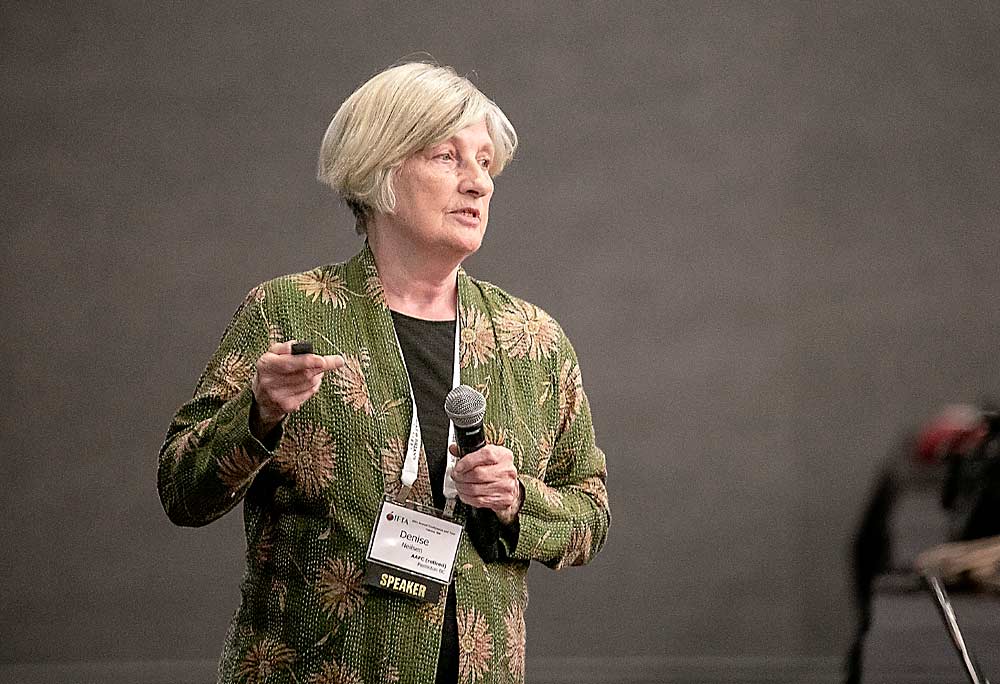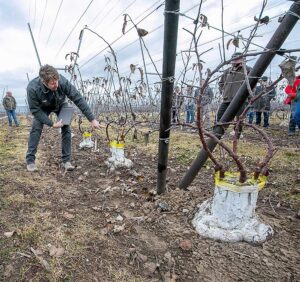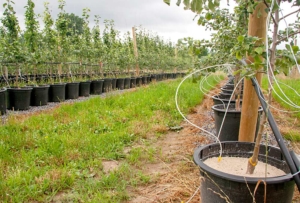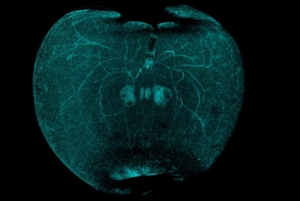The International Fruit Tree Association annual meeting in Yakima, Washington, in February included two days of conference sessions covering climate resilience, orchard nutrition, horticulture, labor efficiency and technology. We spotlight two of the talks below.
Part 1: Climate rewards come with risks, too
Cherry production has expanded in British Columbia as a generally warming climate opened up suitable areas for planting.
“An increase in summer heat has really helped the grape industry, and we’ve seen a decrease in winter minimums that has allowed an expansion of cherries and wine grapes into new territory,” said Denise Neilsen, a retired scientist whose career with Agriculture and Agri-Food Canada focused on orchard irrigation and the influence of climate change on water supplies. “Since 1990, we haven’t had a major cold-hardiness event,” she said — until the past two seasons.
But when temperatures plunged well below zero degrees Fahrenheit for several days in mid-January, after a stretch of mild weather, there were 4,800 or so vulnerable acres of sweet cherries — up more than 1,000 acres since 2016 — and some 10,000 acres of wine grapes at risk.
During a session about climate challenges and cultivating orchard resilience, Neilsen showed maps of how climate change is increasing the generally suitable area for sweet cherry production. Over the past decade, the industry took advantage.
“So why did people plant these tender varieties in an area where in the past we’ve had these cold events?” she said. “All the data was telling us we were OK.”
The result represents a prime example of how climate change is causing crop losses, but it’s far from the only one.
“Climate models can only project, they cannot predict,” Neilsen said. Weather variability prevents climate change models from accounting for extreme events — heat waves, droughts, deluges of rain and frost events — which can cause the most disruption to growers.

But many of those extreme and unpredictable weather events are also driven by climate change and are becoming more common as warming oceans shift global circulation patterns, she said. For years, there wasn’t enough data to definitively link climate change with the increase in weather extremes, but now the relationship is clear, Neilsen said.
“The effects of climate change on temperatures and precipitation are occurring more quickly than previously predicted,” she said.
In the long term, growers in British Columbia and across the West are looking at changes to their water supply, as warmer winters decrease snowpack.
“That puts the water supply timing out of alignment with the infrastructure,” she said. By 2050, models predict insufficient water supply one out of every two years for Kelowna-area irrigation districts with the current infrastructure.
As for the short term, British Columbia cherry growers won’t know the full toll of the freeze until bloom, but in late January, bud death appeared to be around 50 to 60 percent, Neilsen said.
“This is the most challenging season our growers have seen in our lifetime,” BC Cherry Association president Sukhpaul Bal said in a statement in February.
A report issued in February by industry association Wines of British Columbia estimates the cold damage will cause a 97 to 99 percent crop loss and likely significant vine loss. That’s following a loss of over half the wine grape crop last season due to a hard freeze in December 2022.
Part 2: Navigating Honeycrisp nutrition
When it comes to orchard nutrition, sometimes less is more.
“Honeycrisp trees are very sensitive to nitrogen,” said Lailiang Cheng, professor of horticulture at Cornell University, during a presentation on nutrient management. He described the findings from a trial that compared the nutrient uptake and where in the tree those nutrients ended up — what he calls partitioning — in both Honeycrisp and Gala trees grown in sand culture.
Trees in one part of the trial received the equivalent of 6.3, 19, 37.5, 56.3 or 75 pounds of nitrogen per acre. Trees in the higher treatments had poor color, but trees in the lower treatments had small fruit size and struggled with return bloom.
“It’s the middle nitrogen treatment that gives us the best balance or compromise,” Cheng said.
Gala and Honeycrisp move a similar share of their nitrogen supply to their fruit, 38 and 39 percent, respectively. When it comes to potassium, it’s a different story. Gala moves 71 percent into the fruit, while Honeycrisp moves 78 percent.
“In fruit peel tissue, Honeycrisp has 50 percent more potassium than Gala,” Cheng said.

That’s a problem, because the more-mobile potassium competes with calcium, which is needed to stabilize cell membranes. Rootstocks that take up potassium more efficiently, such as G.41, G.890 and G.11, can increase bitter pit risk more than G.214, G.969, B.9 and B.10, Cheng said, making the latter better pairs for Honeycrisp.
In all fruit trees, only a fraction of the calcium trees take up from the soil is transported to the fruit because it is carried passively by the xylem through transpiration, most of which is happening in the shoots and leaves. During fruit development, Gala transports 14 percent of its calcium to the new fruit, while Honeycrisp only moves 6 percent.
The trials also offered some insight into the reason Honeycrisp struggles to secure sufficient calcium in the fruit, making it prone to bitter pit. That rate of calcium accumulation stays consistent for the first six or seven weeks after bloom, but then Honeycrisp fruitlets stop gaining calcium, while Gala fruitlets keep accumulating it.
“Honeycrisp grows so fast that the cell expansion crushes the xylem and makes it nonfunctional,” Cheng said. Galas, on the other hand, only slow down their calcium accumulation a few weeks before harvest.
The nutrient partitioning work he shared was just one piece of a larger, federally funded project known as Root2Fruit. Through that and other efforts, Cornell researchers have compiled new Honeycrisp management recommendations. Cheng shared the highlights on nutrient management during the IFTA meeting but said a more detailed review encompassing rootstock selection, crop load management, return bloom enhancement and irrigation will be published in a report led by Cornell physiologist Terence Robinson in the New York Horticultural Society’s Fruit Quarterly magazine this spring.
Among the recommendations for growers:
—Use G.214, G.969 and B.10 for new Honeycrisp plantings.
—Balance nitrogen applications to hit the sweet spot between color development and fruit size, as bitter pit risk is associated with biennial bearing.
—Adjust the crop load to five or six fruits per square centimeter of trunk cross-sectional area.
—Control vigor to reduce competition for calcium from shoots and leaves.
—Target leaf calcium at 1.5 to 2 percent.
—Target leaf nitrogen at 2 percent in early July and peel sap nitrogen (tested on a golf-ball-sized fruitlet) at 50 to 80 ppm, so that the molar ratio of nitrogen to calcium (i.e., the lab test result that gives the number of nitrogen atoms in the sample divided by the number of calcium atoms) is less than 4.
—Potassium targets should be 1 to 1.3 percent in leaves, and the peel sap ratio of potassium to calcium should be less than 25.
—For blocks with high bitter pit risk exceeding the peel sap ratios above, growers can increase calcium sprays, control irrigation and avoid use of ReTain or Harvista.
—by Kate Prengaman









Leave A Comment